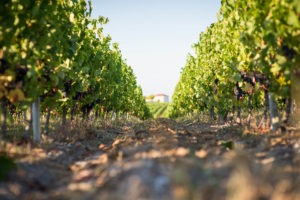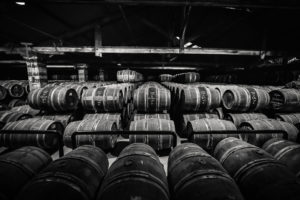Terroir, it’s a subjective and universal concept, which is in the storm… Some people say that Terroir exists, it’s the wine identity. Some others say that it’s an invention of the ‘old world country’ in order to counter the massive arriving of ‘the new world ‘ competition.
It’s true, I don’t really like to say if a wine is good or not… I will tell you if I appreciate it but I let you judge tho. But for the first time, I’m going to side with this debate because for me, Terroir exists, it’s not an invention but a discovery. I can’t imagine a wine without an identity because it’s what is the most important. In France, we are attached to this belief that we sometimes move closer to the belonging notion. Terroir is a little bit our landship patriotism. Moreover we don’t find a translation of this word which comes from Latin ‘terratorium’ and which is a mix of ‘territorium’ and ‘terra’ : territory and earth. In English, Terroir is translated in soil or country…which is quite simplistic.
So, what is the Terroir ? Because E=MC2 it’s nice but you have to prove it ! It’s what I’m gonna try in this article !
“Wine is the sun and earth’s son, but there was also the work as obstetrician” Paul Claudel
I really like to say that Terroir is the correlation between earth, man and God… Earth is like territory, man is the winemaker and God represents the transcendental elements (weather for example)… But in order to simplify, we are going to say more seriously that Terroir is the association of biological factors (vine), human factors (agronomy, viticulture, œnology and history) and natural factors (geology, pedology, climatology and geography); This notion of Terroir, it’s Van Leeuwen and Seguin who are explaining it in 2006. But what is a ‘big’ Terroir (as efficient I mean) ? We can say that a big Terroir is the one which combines this 3 factors in a optimal way !
– Human Factor. Like Claudel says in the introduction’s citation : man is obstetrician… man trained the vines… Because, don’t be fooled, this liana feeded birds and climbed to the sky in order to find the sun. Men shaped the vines but also the soil. Men chose back in the time to install themselves near rivers to facilitate the transportation of their wines. Men are the one who created machines to work in the field and in the cellar. During the Industrial Revolution, men managed to improve the machines, to mechanise. Men are the one who improved also the vinification method which allows today to have safe and quality wines because fermentations are complete. Well, man is an important parameter of Terroir. Each man has got its own conception of viticulture : each wine is the work of this man, it’s its child so its alike.
– Biological Factor. There are more than 1000 types of vines around the world but only a hundred is used to produce quality wine. The type of vine is synonymous of typicity and is associated to the climate. Whithout the climate, it has no more sense. In fact, each type of vine is unique : this one will love fresh climate on limestone soil but this one will prefer temperate climate on gravels… The climate factor is linked to the biological one. So I’m gonna talk about it here : it will be easier to understand. Climate is a correlation between rain quantity, the number of sun’s hours and temperature. Climate gives access to a very important œnological concept : ripeness. Thanks to ripeness, the harvests date is set up.
It exists different types of ripeness : the phenological one (veraison) and the viticultural one (when the foliage stops growing) are visible in the vineyard ; the technological one (relation between sugar and acidity), the phenolic one (very important because it’s all about tanins and anthocyanins), the skin maturity (permeability and skin thickness) and finaly the aromatic one (skin and pulp) are well-known thanks to a grappe tasting.
– Finally the Natural Factor. The soil is very important, we can confused it with Terroir. The soil is geology (science of earth and its history), pedology (science of soil, its formation and evolution) and agronomy (science of agriculture). The winemaker has to know its soil. It has to be aware of the important different variables for which it has no control and which will allow it to choose the type of vine and its viticulture mode. The soil temperature is a first variable : the dry or not deep soils are hot soils for example. It is necessary to plant a early type of vine. The mineral nutrition of the soil is also important and will vary with the type of wine produced. The white wines need a lots of nitrogen to be aromatic. In the contrary, for red wines, the nitrogen alimentation of the vine has do be reduced. Finaly, the water alimentation is one of the most important variable : the winemaker has to choose if it wants to irrigate or not. The hydric duress is welcome for some type of vines but not for the Sauvignon Blanc for example. All these elements have to be took into account for the vines and rootstock plantation.
« Wine contains two strenghts which melt in each other once the fermentation over : in fact, the vine roots are going deeply in the soil, take out the magnetic strenght of earth to concentrate it in the grape. The sun, it, bathes the vine stocks in its great cosmic strenght. The two strenghts cumulate days after days in the grains until the harvest moment. It’s here the other translation which is going straightly to the essence full of imagery of things : wine adds the primor strenghts of the first elements, earth, water, air, fire. »
Marcel Scipion
For Denis Dubourdieu, who is not to introduce anymore, the Terroir effect will be ‘the capacity of a territory to produce, thanks to the human know-how, a wine which has a typical taste, appreciated by the market which is able to recognize its value and singularity for a long time’. For me, it’s more the Terroir expression. It’s the proof that this notion exists. I admit that it’s totaly subjectiv. You can believe it or not. But for me, as I underline it during my introduction, I believe in. To erase the Terroir gives me the sad impression to fade the wine image. Terroir is poetic, it’s an image that allows us to travel. But in the same time, it’s quite real : human, plant and something else ! It’s its expression which allows to feel it : Denis Dubourdieu talks about recognition. So, lets see in Bordeaux what might be this expression and then lets go more precisely in the comparison of two close Terroirs : Pomerol and St Emilion.
The Bordeaux Taste
– ‘Bordeaux’ color : I have to underline that in the French language, Bordeaux is synonymous of its color. It’s not the only wine in the world to have this particularity : the color Bourgogne (Burgundy) also exists. The Bordeaux color can be describe as purple red. There is a strong visual singularity.
– No alcoholic heat
– Fresh fruits (black and red), complex aromas associated to blooming rose notes
– Smoky bouquet with evolution on truffle
– Smooth and fresh tanins at the begining
– Concentrated and silky in finish
– Sweetness without sugar
Lets see now the caracteristics of two close Terroirs :
The Pomerol taste
Pomerol is 735 hectares with 190 declarants. With 70% of Merlot and 30% of Bouchet (Cabernet Franc), it’s a wine appellation which has been created in 1936 and which is really famous. The heart of Pomerol is a clay plateau with gravels. This plateau is surrounded by a gravels belt and we can also find some plots with gravels and sand more and less muddy.
Pomerol wines, the Terroir expression, have generally a deep and dark crimson color. The nose is a powerful and complex bouquet, warm with truffle, blackcurrant, raspberry, fresh cream and grilled almond notes. The attack is full of harmony, round and smooth. Evolution is fleshy and dense. The structure is tannic (the most tannic of Bordeaux) with blackcurrant, truffle, roasted grains and even meat in finish.
The Saint Emilion taste
Saint Emilion is the neighbour of Pomerol and represents 5150 hectares with 971 declarants. With, in the contrary of Pomerol, 3 type of vines (Merlot, Cabernet Franc but also Cabernet Sauvignon with 10% of the vine population), the Saint Emilion soil are varied and if some of the plots will never have given beautiful wines, they will never have been part of the appellation. Saint Emilion is on a limestone plateau, even clay-limestone is the heart and in the East and North of the city. In the North-West, soils are siliceous or clayey gravels. There are also plots with siliceous alluviums with small gravels more and less sandy.
Wines of Saint Emilion, in the clay-limestone area, have a middle intense color on crimson ruby if there is a lot of clay or vermillon if there is a lot of limestone. The nose is vivacious and subtle, full of flowers. If there is limestone, we can even smell some earthy notes which are not unpleasant. The mouth is structured with light tannins. Often slender, Saint Emilion wines can be stern during youth. But fine and elegant, these wines are fruity with vegetal notes which will evoluate through liquorice or mint during the great age.



